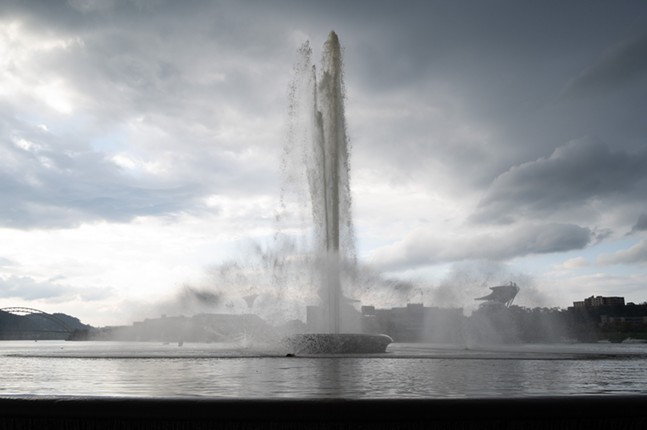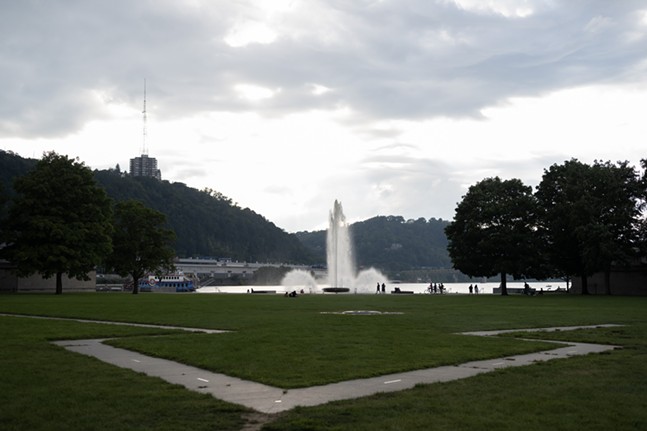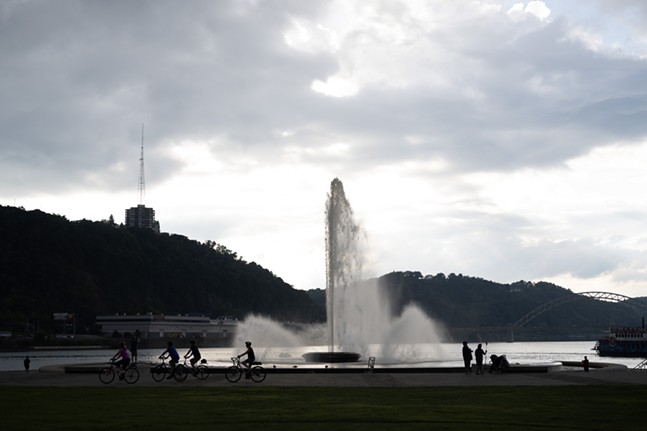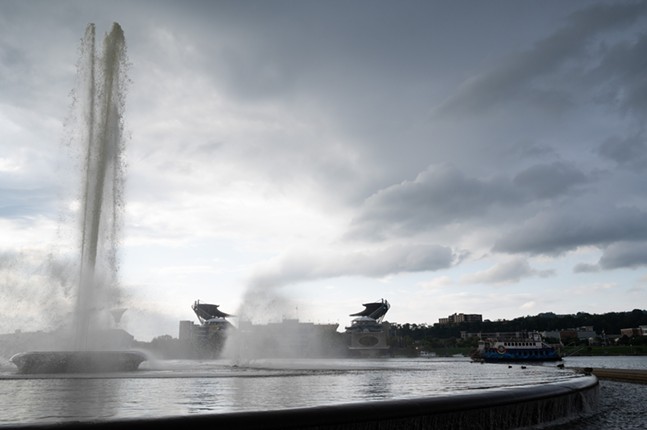Before Point State Park was developed into the green space Pittsburghers know today, Frank Lloyd Wright imagined it as a UFO-shaped civic center with a grand automobile ramp. The scheme, first proposed in 1947, emphasized modernity and the luxury of car travel, and included an opera house, three movie theaters, a glass-enclosed aquarium — and a fountain.
Though Wright’s civic center ideas never came to fruition, he’s credited for the Point State Park fountain, which celebrates its 50th anniversary on Aug. 30. Completed in 1974 to cap off the newly constructed Point State Park, a National Historic Landmark, the fountain remains an attraction and visual focal point, drawing 200,000 monthly visitors during the summer.
Sitting at the confluence of the Allegheny and Monongahela Rivers, the 152-foot-wide fountain sprays water up to 200 feet in the air and was once supplied by Pittsburgh’s legendary fourth river. Today, maintained by the Pennsylvania Department of Conservation and Natural Resources, it uses three pumps to recirculate 1.2 million gallons of filtered water every hour. A weathervane atop its pumphouse regulates the height of the fountain’s spray based on wind conditions so onlookers stay dry.
Matt Galluzzo, President and CEO of Riverlife, the nonprofit that facilitated the fountain’s latest renovation in 2013, recently described the fountain as “the crown jewel for our riverfront system.”
Viewed this way 75 years after Wright’s original proposal, the vision of a car-dominated megastructure might seem far-fetched by contrast. But the fountain’s history reveals it to be the potent symbol Wright envisioned and key to the image of Pittsburgh that city leaders of various eras hoped to convey.
Riverlife has its offices near Allegheny Landing Park, a riverfront park currently undergoing a redesign. Galluzzo tells Pittsburgh City Paper that with every iteration of urban redevelopment, similar questions arise.
“How do you make a park relevant when it was designed for a context that just doesn’t exist anymore?” asks Galluzzo. “How does this reflect contemporary ideas about what parks can be?”
The Point has a 250-year-long history. The low-lying triangular parcel of land was settled by Indigenous people including the Seneca and Shawnee, currently highlighted at the Homelands exhibit at the Fort Pitt Museum steps away from the fountain. European colonizers, fur trappers, and a Lt. George Washington all recognized the Point’s strategic importance. The site was fortified and played a significant role in the French and Indian War (1754-1763), American Revolution, and in the early American republic. The Fort Pitt blockhouse remains the oldest building in Pittsburgh.
The fountain’s conception arguably began with the arrival of Pittsburgh's first railroad in 1852. As the city was transformed by industrialization and the rise of iron, steel, coal mining, and glass, the Point, formerly home to gardens, houses, and churches, became occupied by rail yards and warehouses by the end of the century.
Talks about reclaiming the area began as early as the 1910s, and after World War II, when Pittsburgh earned the dubious nickname “the Smoky City,” redevelopment efforts began in earnest. The newly established Allegheny Conference on Community Development — spearheaded by corporate leaders including department store magnate Edgar Kaufmann — implemented pollution controls and sought to redevelop “the Golden Triangle” and address “the Point problem,” soliciting proposals like Wright’s.
Pittsburgh’s storied Renaissance I plan officially kicked off in 1950 with the demolition of a small house. The plan culminated with the redevelopment of the Point, which required dismantling two bridges. The new Point State Park debuted with 59 acres, a plaza, and the “modern” and “gigantic” fountain, as it’s described in its National Register of Historic Places nomination, as its centerpiece. At its 1974 kickoff, it was among the world’s tallest fountains.
The Pittsburgh Post-Gazette from Aug. 31, 1974 describes the fountain’s opening ceremony, which saw crowds gathered to see the spray on “a rainy morning turned sunny just in time.”
“The life of the river was a panorama in the background, whistling towboats pushing barges, small pleasure craft, and on the far banks freight trains and the cable cars of the Duquesne incline,” the paper wrote, also noting that the fountain represented potential for “beautification of the riverbanks” and “enhancing the quality of Pittsburgh life.”
By the mid-1990s, says Riverlife’s Matt Galluzzo, “the fountain was really starting to show its wear.”
In a “story of partnerships,” a task force including the Allegheny Conference convened, forming Riverlife in 2002. The organization, which aims to develop “world-class” riverfronts for the region, raised $11.6 million for a top-to-bottom fountain renovation (part of a larger restoration of Point State Park), shutting it off for four years starting in April 2009.
Galluzzo says that, although visitors are prohibited from swimming in the fountain, “it really creates opportunities for different types of engagement with the water.”
“I think the rivers generally are part of our DNA as Pittsburghers,” he tells City Paper. “The symbol for that is the fountain at Point State Park… and I [think] this is the town square.”
Today, as city planners envisioned, Point State Park serves as a recreational space, cultural center, and the Golden Triangle’s “front lawn” — even hosting a river circus — as well as the backdrop for engagements, family reunions, or just lunch Downtown.
Having stood for decades as a landmark of post-industrial transition, the fountain continues to face a future in flux, now withstanding climate change. Due to unprecedented flooding that submerged the fountain in April, Point State Park temporarily closed just shy of its 50th anniversary.
“We are going to see, and have seen, an increase in climate-related events,” says Galluzzo. Due to silt stirred up along the riverbanks, “the [fountain’s] cleanup is not inconsequential,” he says, emphasizing the need for further urban planning.
“I have a belief that this is the most important time in Pittsburgh’s history,” Galluzzo tells CP. “We can really move the needle as we think about [and] advance what a 21st century city can look like.”
“I think the real beauty is that the benefits of that work will accrue to our children and our grandchildren and people we’ll never meet,” he adds. The fountain is “a pretty powerful place [knowing] this multi-generational impact that you can have.”





